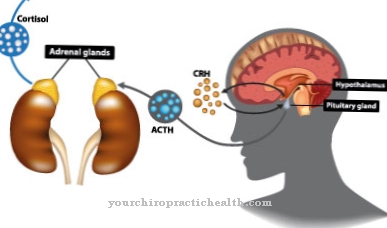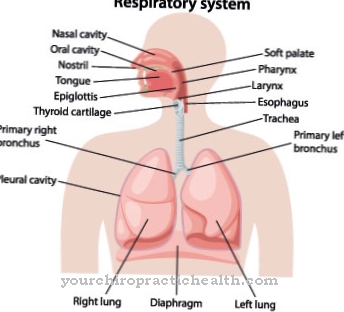The Pneumonitis is a lung disease that is often recognized very late. The triggers for this disease are not caused by infection. Several causes of pneumonitis can play together and also be the result of other diseases.
What is pneumonitis?
A Pneumonitis is an inflammation in the lung tissue. Pneumonitis is often confused with pneumonia, the classic pneumonia. In pneumonitis, the triggers are not bacteria or fungi, but pneumotoxic influences. These are toxic effects on the lungs. Chronic inflammation in the lung tissue and scarring of the alveoli develop. Normal oxygen transport via the blood is no longer possible.
causes
Some of the causes that cause pneumonitis include drugs. Noxa is a substance that has a damaging and pathogenic effect on the human organism. In particular, drugs that are taken during chemotherapy and must be supplied to the body fall into this category. A side effect of radiation therapy can also be pneumonitis in the irradiated areas.
Pneumonitis can also develop when inhaling chemical substances, gases and toxic smoke. Pneumonitis is also triggered by exogenous allergic alveolitis. It is an allergic inflammation of the alveoli (structural elements in the lungs in which gas exchange takes place). Substances such as fine dust are absorbed through inhalation. In rare cases, pneumonitis can also occur as a result of the disease toxoplasmosis.
Symptoms, ailments & signs

© SENTELLO - stock.adobe.com
The first symptoms that occur with pneumonitis are a dry, tickly cough and shortness of breath. In some cases, the body temperature rises sharply and the person suffers from a fever. A worsening of the general condition and a typical feeling of illness are observed in the patients. After radiation treatment, these symptoms can appear four to twelve weeks, and even several months after therapy.
With the modern techniques used, the diseases of pneumonitis have significantly decreased. The severity of the symptoms depends on the compensatory capacity of the lung volume irradiated with a low dose. The symptoms are exacerbated by so-called superinfections. In particularly serious cases, ARDS, an acute respiratory distress syndrome, can occur.
This is a massive inflammatory reaction of the human lungs to various factors that cause tissue damage. As a result of the increase in pressure in the pulmonary circulation, cor pulmonale can also occur, which means that the heart is heavily stressed by pressure. The respiratory distress syndrome and the cor pulmonale can lead to death.
After several weeks, the pneumonitis usually goes away on its own.Pneumonitis can result in irreversible fibrosis of the lung volume that has been exposed to radiation. Permanent lung dysfunction can occur.
Diagnosis & course of disease
A chest exam is done to diagnose pneumonitis. Only after four to eight weeks after the therapy can the x-rays show frosted opacities in the lung tissue. In order to get a better picture of the lungs, an X-ray is followed by a computed tomography, which shows high-resolution images of the lungs.
Lung function tests also show the first signs of a possible disease. The patient inhales air and has to exhale it again within a specific period of time. This allows the doctor to measure how efficiently the lungs are working. An oximeter is often used to help, which can assess how much oxygen is in the bloodstream. A clip is attached to the finger. This method is completely painless for the patient.
If a bronchoscopy is performed, it is a lungoscopy. An endoscope is inserted through the windpipe into the main bronchi. A tissue sample can also be taken from the lungs.
Complications
Because of pneumonitis, people suffer from various respiratory problems. This usually results in shortness of breath and a strong cough. This can also lead to an insufficient supply of oxygen, so that the person concerned looks exhausted and tired. The internal organs can also be irreversibly damaged by this undersupply.
Fever and a general feeling of illness can occur as a result of illness and have a very negative effect on the patient's everyday life. Furthermore, strenuous activities or physical stress and sports are usually no longer possible for the person concerned. Usually, pneumonitis can be treated with medication.
Treatment with antibiotics is also necessary for pneumonia. If the person concerned has severe breathing difficulties, therapy with oxygen is necessary. In some cases, pneumonitis can also lead to psychological complaints or severe depression. Whether there will be a complete cure with the treatment of pneumonitis cannot be universally predicted. The patient's life expectancy may also be reduced.
When should you go to the doctor?
Pneumonitis must always be treated by a doctor. If the disease is not treated, it can, in the worst case, lead to death or other complications. In the case of pneumonitis, the doctor should be consulted if the person concerned suffers from breathing difficulties for a long period of time.
The disease manifests itself primarily through shortness of breath and dry cough, even if the person concerned is not exerting himself. Often, a fever can also indicate the disease. If these symptoms occur over a longer period of time and do not go away on their own, a doctor must be consulted in any case. Likewise, decreased performance or persistent fatigue can indicate pneumonitis and should be investigated.
The first diagnosis and examination of pneumonitis can be made by a general practitioner or by an ENT doctor. However, since further treatment depends on the exact cause of the pneumonitis, an additional specialist is usually necessary. Early diagnosis and treatment have a positive effect on the course of the disease.
Treatment & Therapy
In the case of chemically induced pneumonitis, it is advisable to suspend treatment with radiation therapy in order to largely rid the body of chemical components. This should alleviate the symptoms and help to improve. In some cases of pneumonitis, other methods are used to help cure the inflammation.
The supply of corticosteroids causes a suppression of the immune system. This reduces the inflammation in the lungs. Corticosteroids are taken in the form of tablets. Long-term use can increase the risk of contracting an infection, as the performance of the immune system is impaired. Ingestion has also been linked to the onset of the bone disease osteoporosis.
Oxygen therapy is also necessary if the patient has severe breathing problems. If water collects in the lungs, breathing is severely restricted. Oxygen must be absorbed into the organism through an oxygen mask or as a result of intubation. Many sick people need permanent oxygen therapy. In order to keep the airways open, stents are also used to keep the walls between the windpipe and the bronchi apart, especially in the case of constrictions caused by tumors.
prevention
Regular check-ups are necessary in order to quickly detect changes in lung tissue during radiation therapy. In individual cases, an extended diagnosis is arranged to assess the severity. An early dose reduction or a change of therapy can contain the risk of developing pneumonitis and reduce long-term damage. If the treatment is continued, there is always the risk of developing pneumonitis.
Aftercare
Since pneumonitis is recognized relatively late in most cases, those affected with this disease usually have only a few and only limited follow-up measures available. Those affected are therefore definitely dependent on a diagnosis as early as possible in order to alleviate the symptoms of the disease and also to avoid other complications.
There can be no self-healing, so a visit to a doctor is always necessary for this disease. The earlier this person is contacted, the better the further course of the disease is often. The treatment itself is usually done with the help of various drugs. Those affected should always take them regularly and observe the prescribed dosage.
Likewise, those affected by pneumonitis should not undertake unnecessary exertion or stressful activities. Therefore, many patients are dependent on the help of other people in their everyday life. Loving conversations have a positive effect on the further course of the disease and can above all limit or prevent psychological complaints. In general, however, pneumonitis reduces the life expectancy of those affected in many cases.
You can do that yourself
People with pneumonitis should reduce the consumption of pollutants through the air to a minimum. In particular, avoid environments where inhalation of nicotine, dyes or other toxins occurs. Smoking is strictly forbidden as part of self-help. Rooms must be ventilated regularly and spending time in nature strengthens the organism.
Since a chronic course of the disease is possible in the further process, the body's own defense system needs sufficient support early on. A balanced diet and a healthy lifestyle are essential for this. Obesity should be avoided and potential stressors should be reduced. The sleep rhythms must be observed and sleep hygiene must be optimized. Inner strength can be built up using various relaxation techniques. Special breathing techniques also help to alleviate the existing symptoms.
Pneumonitis often causes shortness of breath. The victim should learn not to panic. Strong anxiety or panic phases intensify the symptoms and thus worsen the overall situation. In order to cope with the disease, it is important to always remain calm and to develop different strategies early on that offer a way out in critical situations. Physical stress should be avoided. As soon as a strenuous activity is carried out, regular breaks and timely rest periods must be observed.


.jpg)














.jpg)







.jpg)


